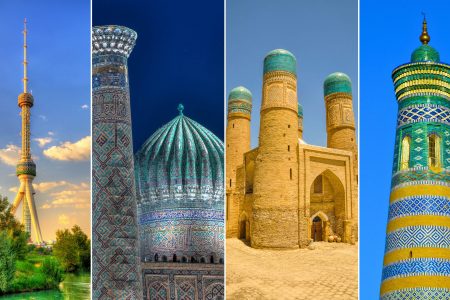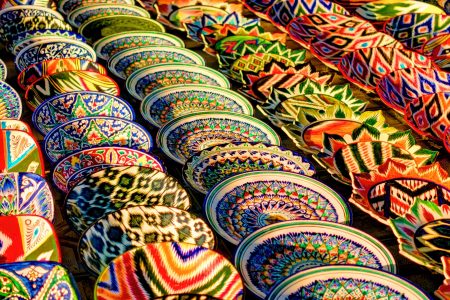With its unique architecture, interesting history as well as friendly people of Bukhara attracts tourists from all over the globe. Holy Bukhara is one of the most important and touristic cities of Uzbekistan. The historic city center was introduced in the UNESCO World Heritage List in (1993) and the age of the city is more than 2,500 years old, with hundreds of ancient landmarks and monuments.
In China in the 5th century Bukhara city was called Nyumi, later in the sources of the Tang Empire it was called An, Ansi, Buho and Buhe. Nevertheless, in historical sources it is often called Bukhara. According to etymologists, the name is derived from the Sogdian word “buharak” and translates as “happy place”. Bukhara is also called the city of poetry and fairy tales, because the whole old city is famous for legends and stories.
Bukhara with its rich history, which is almost three thousand years was one of the cities that has made an invaluable contribution to the world civilization. In the ancient times, the definition of Bukhara city has spread throughout the world, because of advancement science, enlightenment and culture. The location of Bukhara at the crossroads of the Great Silk Road from the earliest times stimulated the development of handicrafts and trade.
The city of Bukhara has been changed its status as the capital or the second most important city during the reigns of different rulers, it was famous not only for its mosques and madrassas, mausoleums, well-known scholars of the globe and prominent figures of the Islamic world, but also for its palaces, luxury houses, caravanserais, baths as well as commercial indoor bazaars with many domes. Preserved indoor bazaars at the crossroads of the city – it was built in the neighborhoods of the old city and performed different functions in the form of indoor bazaars were exactly the same described in the oriental fairy tales and movies we love to read and watch from our childhood, which make a great impression on us.
In the middle Ages, Bukhara was considered the holy and glory city of all Muslims in the Central Asia, where the most famous people gathered. Well-known Imam Al-Bukhari (9th century) was born, grew up, performed his Islamic knowledge and passed away in the territory of current Uzbekistan. He was an author of Al-Jame ‘al-Sahih, the second most important religious book in Islam after holly Qur’an.
On top of that Abu Ali ibn Sino (10th-11th centuries), was born in a small village in Bukhara region, performed numerous scientific researches and wrote numerous guide books dedicated to medicine in his lifetime in Bukhara and in other famous Muslim cities. It is vital to mention that he was well-known medical scholar, not only in Muslim world, but also in the world of medicine as Avisenna.
One of the holiest figures in Islam, the founder of Naqshbandi sect is Sheikh Bahauddin Naqshband (14th century), it is famous around the world as a major figure and leader of Sufism. Making a pilgrimage to the mausoleum of Bahauddin Naqshband was equated with a pilgrimage to Mecca in the Islamic world. The mausoleum of Bahauddin Naqshband is still considered the holiest place in the globe and it is visited by thousands of pilgrims and tourists from all over the world. Bukhara is in the first place in terms of the number of historical monuments in Uzbekistan, and the ancient city can be observed by walking through the old city of Bukhara.
For the contribution of Muslim scholars, philosophers, architects and poets, the city has been awarded with the honorary titles of “The peak of Islam”, “Bukhara Sharif”, “Holy City”. In the middle Ages, seven cities around the world were given the title of Sharif because of their reputation as religious centers * (Mecca, Medina, Mazar-i-Sharif, Baghdad, Jerusalem, Damascus, and Bukhara-i- Sharif). One of them is Bukhara-i-Sharif (a holy Bukhara city of high reverence), which is one of the most common names of ancient Bukhara. Bukhara has been called by different names from ancient time. The city has also played an important role in promoting Islam and decision-making. Due to the fact that Bukhara has become one of the strongest centers of Islam in the East, because of Muslim morality, culture and jurisprudence, it was given the title of “Qubbat ul-Islam” – “Dome of Islam” in the early 9th century. At present time, Bukhara is one of the most visited cities in Uzbekistan and it is rapidly developing in the field of tourism.
At the same time, the city is a center of modern industry and culture. The main economy of Bukhara region is consist of agriculture (cotton, silkworm, melons, vegetables, grain, fruit gardens and farms). Livestock is a developed industry in Bukhara region, which includes cattle, sheep, goats, horses, camels and poultry. Especially, Bukhara Karakul sheep`s wool is popular with its high quality around the globe and Karakul wool as supplies are exported to oversee countries.



